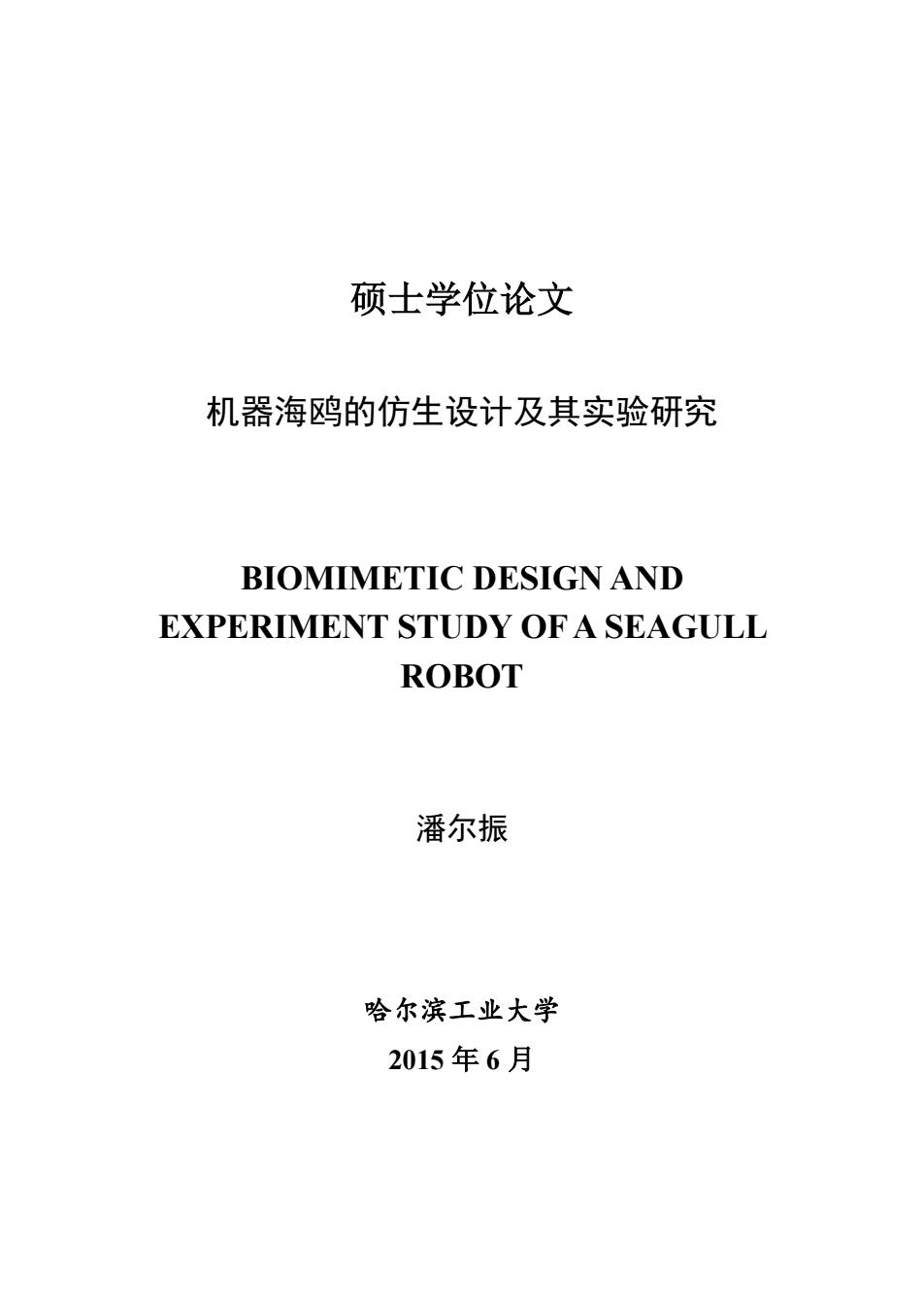
硕士学位论文 机器海鸥的仿生设计及其实验研究 BIOMIMETIC DESIGN AND EXPERIMENT STUDY OFA SEAGULL ROBOT 潘尔振 哈尔滨工业大学 2015年6月
硕士学位论文 机器海鸥的仿生设计及其实验研究 BIOMIMETIC DESIGN AND EXPERIMENT STUDY OF A SEAGULL ROBOT 潘尔振 哈尔滨工业大学 2015 年 6 月
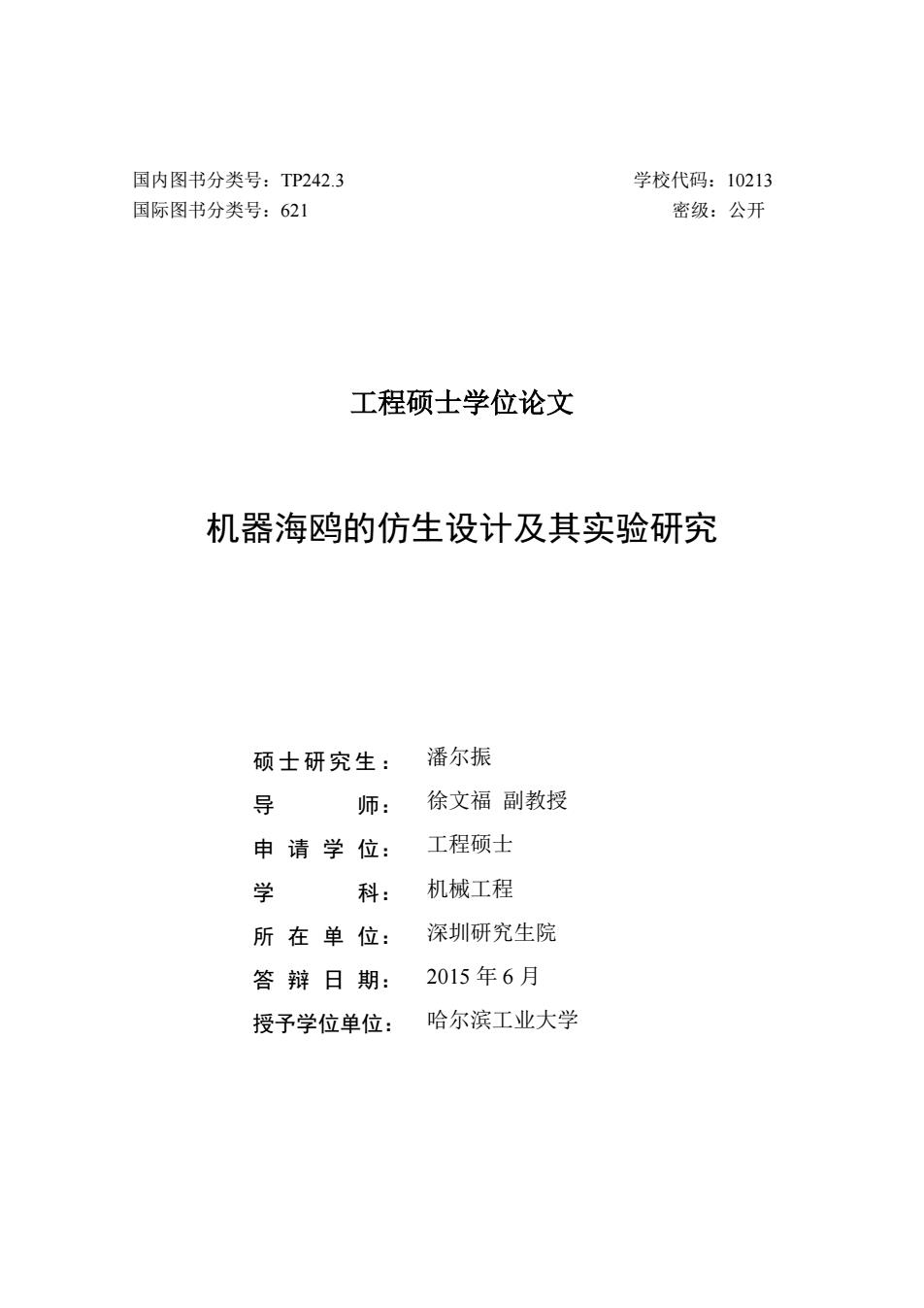
国内图书分类号:TP242.3 学校代码:10213 国际图书分类号:621 密级:公开 工程硕士学位论文 机器海鸥的仿生设计及其实验研究 硕士研究生: 潘尔振 导 师: 徐文福副教授 申请学位: 工程硕士 学 科: 机械工程 所在单位: 深圳研究生院 答辩日期: 2015年6月 授予学位单位: 哈尔滨工业大学
国内图书分类号:TP242.3 学校代码:10213 国际图书分类号:621 密级:公开 工程硕士学位论文 机器海鸥的仿生设计及其实验研究 硕士研究生: 潘尔振: 导 师: 徐文福: 副教授 申 请 学 位: 工:程硕士 学 科: 机械工程 : 所 在 单 位: 深圳研究生院 : 答 辩 日 期: 201:5 年 6 月 授予学位单位: 哈尔滨工业大学 :
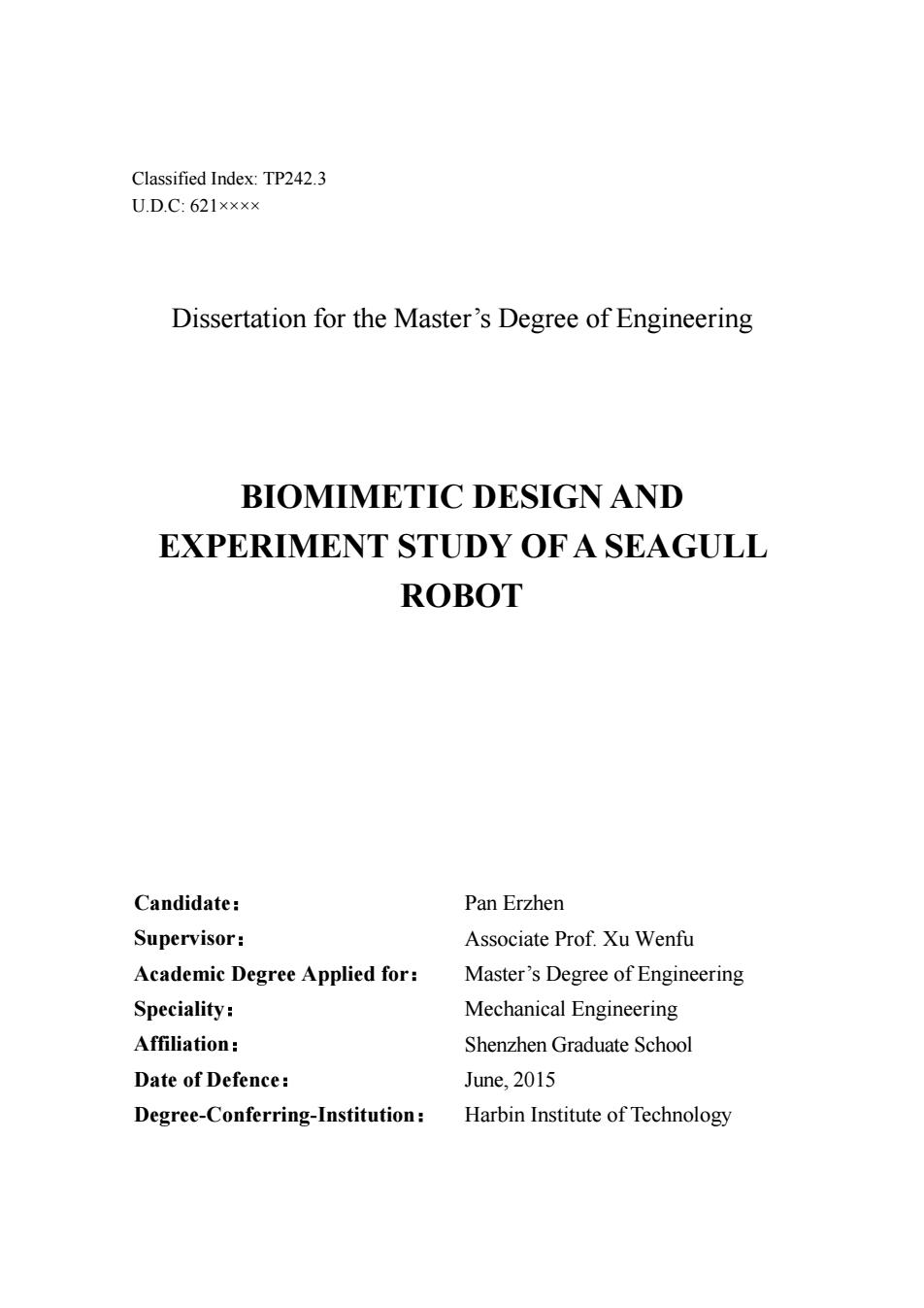
Classified Index:TP242.3 U.D.C:621×××× Dissertation for the Master's Degree of Engineering BIOMIMETIC DESIGN AND EXPERIMENT STUDY OFA SEAGULL ROBOT Candidate: Pan Erzhen Supervisor: Associate Prof.Xu Wenfu Academic Degree Applied for: Master's Degree of Engineering Speciality Mechanical Engineering Affiliation: Shenzhen Graduate School Date of Defence: June,2015 Degree-Conferring-Institution: Harbin Institute of Technology
Classified Index: TP242.3 U.D.C: 621×××× Dissertation for the Master’s Degree of Engineering BIOMIMETIC DESIGN AND EXPERIMENT STUDY OF A SEAGULL ROBOT Candidate: Pan Erzhen Supervisor: Associate Prof. Xu Wenfu Academic Degree Applied for: Master’s Degree of Engineering Speciality: Mechanical Engineering Affiliation: Shenzhen Graduate School Date of Defence: June, 2015 Degree-Conferring-Institution: Harbin Institute of Technology
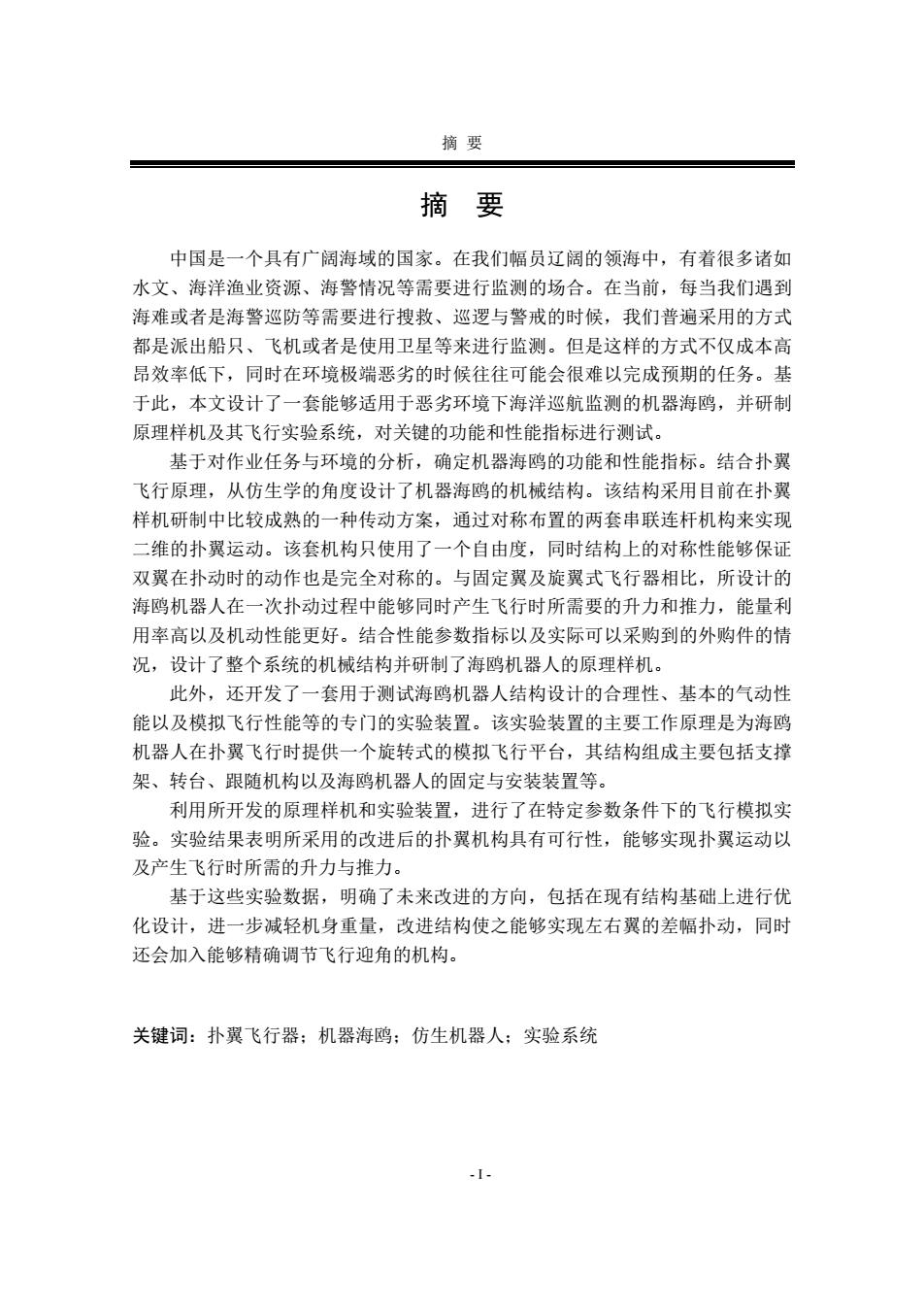
摘要 摘要 中国是一个具有广阔海域的国家。在我们幅员辽阔的领海中,有着很多诸如 水文、海洋渔业资源、海警情况等需要进行监测的场合。在当前,每当我们遇到 海难或者是海警巡防等需要进行搜救、巡逻与警戒的时候,我们普遍采用的方式 都是派出船只、飞机或者是使用卫星等来进行监测。但是这样的方式不仅成本高 昂效率低下,同时在环境极端恶劣的时候往往可能会很难以完成预期的任务。基 于此,本文设计了一套能够适用于恶劣环境下海洋巡航监测的机器海鸥,并研制 原理样机及其飞行实验系统,对关键的功能和性能指标进行测试。 基于对作业任务与环境的分析,确定机器海鸥的功能和性能指标。结合扑翼 飞行原理,从仿生学的角度设计了机器海鸥的机械结构。该结构采用目前在扑翼 样机研制中比较成熟的一种传动方案,通过对称布置的两套串联连杆机构来实现 二维的扑翼运动。该套机构只使用了一个自由度,同时结构上的对称性能够保证 双翼在扑动时的动作也是完全对称的。与固定翼及旋翼式飞行器相比,所设计的 海鸥机器人在一次扑动过程中能够同时产生飞行时所需要的升力和推力,能量利 用率高以及机动性能更好。结合性能参数指标以及实际可以采购到的外购件的情 况,设计了整个系统的机械结构并研制了海鸥机器人的原理样机。 此外,还开发了一套用于测试海鸥机器人结构设计的合理性、基本的气动性 能以及模拟飞行性能等的专门的实验装置。该实验装置的主要工作原理是为海鸥 机器人在扑翼飞行时提供一个旋转式的模拟飞行平台,其结构组成主要包括支撑 架、转台、跟随机构以及海鸥机器人的固定与安装装置等。 利用所开发的原理样机和实验装置,进行了在特定参数条件下的飞行模拟实 验。实验结果表明所采用的改进后的扑翼机构具有可行性,能够实现扑翼运动以 及产生飞行时所需的升力与推力。 基于这些实验数据,明确了未来改进的方向,包括在现有结构基础上进行优 化设计,进一步减轻机身重量,改进结构使之能够实现左右翼的差幅扑动,同时 还会加入能够精确调节飞行迎角的机构。 关键词:扑翼飞行器:机器海鸥:仿生机器人:实验系统
摘 要 - I - 摘 要 中国是一个具有广阔海域的国家。在我们幅员辽阔的领海中,有着很多诸如 水文、海洋渔业资源、海警情况等需要进行监测的场合。在当前,每当我们遇到 海难或者是海警巡防等需要进行搜救、巡逻与警戒的时候,我们普遍采用的方式 都是派出船只、飞机或者是使用卫星等来进行监测。但是这样的方式不仅成本高 昂效率低下,同时在环境极端恶劣的时候往往可能会很难以完成预期的任务。基 于此,本文设计了一套能够适用于恶劣环境下海洋巡航监测的机器海鸥,并研制 原理样机及其飞行实验系统,对关键的功能和性能指标进行测试。 基于对作业任务与环境的分析,确定机器海鸥的功能和性能指标。结合扑翼 飞行原理,从仿生学的角度设计了机器海鸥的机械结构。该结构采用目前在扑翼 样机研制中比较成熟的一种传动方案,通过对称布置的两套串联连杆机构来实现 二维的扑翼运动。该套机构只使用了一个自由度,同时结构上的对称性能够保证 双翼在扑动时的动作也是完全对称的。与固定翼及旋翼式飞行器相比,所设计的 海鸥机器人在一次扑动过程中能够同时产生飞行时所需要的升力和推力,能量利 用率高以及机动性能更好。结合性能参数指标以及实际可以采购到的外购件的情 况,设计了整个系统的机械结构并研制了海鸥机器人的原理样机。 此外,还开发了一套用于测试海鸥机器人结构设计的合理性、基本的气动性 能以及模拟飞行性能等的专门的实验装置。该实验装置的主要工作原理是为海鸥 机器人在扑翼飞行时提供一个旋转式的模拟飞行平台,其结构组成主要包括支撑 架、转台、跟随机构以及海鸥机器人的固定与安装装置等。 利用所开发的原理样机和实验装置,进行了在特定参数条件下的飞行模拟实 验。实验结果表明所采用的改进后的扑翼机构具有可行性,能够实现扑翼运动以 及产生飞行时所需的升力与推力。 基于这些实验数据,明确了未来改进的方向,包括在现有结构基础上进行优 化设计,进一步减轻机身重量,改进结构使之能够实现左右翼的差幅扑动,同时 还会加入能够精确调节飞行迎角的机构。 关键词:扑翼飞行器;机器海鸥;仿生机器人;实验系统
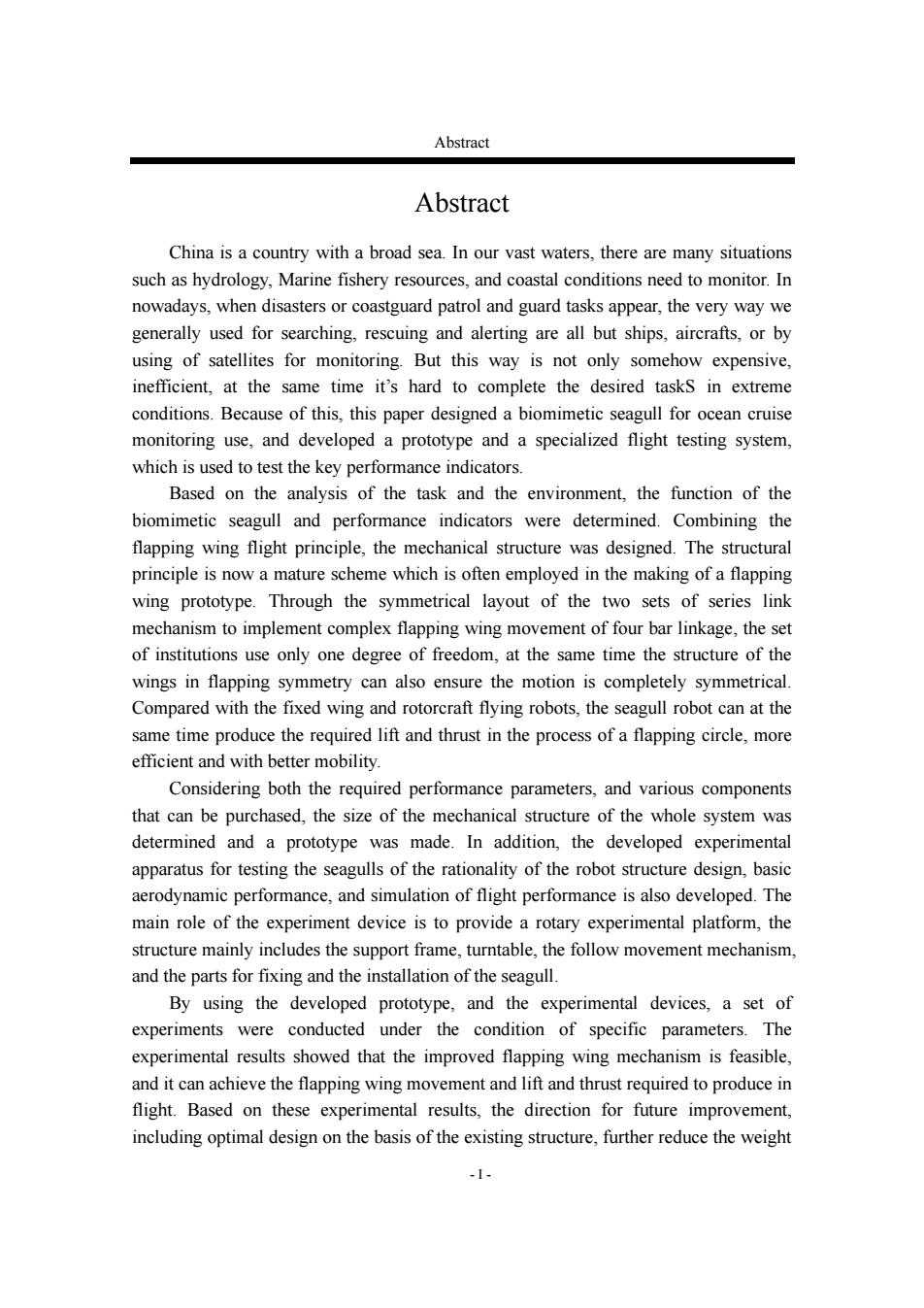
Abstract Abstract China is a country with a broad sea.In our vast waters,there are many situations such as hydrology,Marine fishery resources,and coastal conditions need to monitor.In nowadays,when disasters or coastguard patrol and guard tasks appear,the very way we generally used for searching,rescuing and alerting are all but ships,aircrafts,or by using of satellites for monitoring.But this way is not only somehow expensive, inefficient,at the same time it's hard to complete the desired taskS in extreme conditions.Because of this,this paper designed a biomimetic seagull for ocean cruise monitoring use,and developed a prototype and a specialized flight testing system, which is used to test the key performance indicators. Based on the analysis of the task and the environment,the function of the biomimetic seagull and performance indicators were determined.Combining the flapping wing flight principle,the mechanical structure was designed.The structural principle is now a mature scheme which is often employed in the making of a flapping wing prototype.Through the symmetrical layout of the two sets of series link mechanism to implement complex flapping wing movement of four bar linkage,the set of institutions use only one degree of freedom,at the same time the structure of the wings in flapping symmetry can also ensure the motion is completely symmetrical. Compared with the fixed wing and rotorcraft flying robots,the seagull robot can at the same time produce the required lift and thrust in the process of a flapping circle,more efficient and with better mobility. Considering both the required performance parameters,and various components that can be purchased,the size of the mechanical structure of the whole system was determined and a prototype was made.In addition,the developed experimental apparatus for testing the seagulls of the rationality of the robot structure design,basic aerodynamic performance,and simulation of flight performance is also developed.The main role of the experiment device is to provide a rotary experimental platform,the structure mainly includes the support frame,turntable,the follow movement mechanism, and the parts for fixing and the installation of the seagull. By using the developed prototype,and the experimental devices,a set of experiments were conducted under the condition of specific parameters.The experimental results showed that the improved flapping wing mechanism is feasible, and it can achieve the flapping wing movement and lift and thrust required to produce in flight.Based on these experimental results,the direction for future improvement, including optimal design on the basis of the existing structure,further reduce the weight -I-
Abstract - I - Abstract China is a country with a broad sea. In our vast waters, there are many situations such as hydrology, Marine fishery resources, and coastal conditions need to monitor. In nowadays, when disasters or coastguard patrol and guard tasks appear, the very way we generally used for searching, rescuing and alerting are all but ships, aircrafts, or by using of satellites for monitoring. But this way is not only somehow expensive, inefficient, at the same time it’s hard to complete the desired taskS in extreme conditions. Because of this, this paper designed a biomimetic seagull for ocean cruise monitoring use, and developed a prototype and a specialized flight testing system, which is used to test the key performance indicators. Based on the analysis of the task and the environment, the function of the biomimetic seagull and performance indicators were determined. Combining the flapping wing flight principle, the mechanical structure was designed. The structural principle is now a mature scheme which is often employed in the making of a flapping wing prototype. Through the symmetrical layout of the two sets of series link mechanism to implement complex flapping wing movement of four bar linkage, the set of institutions use only one degree of freedom, at the same time the structure of the wings in flapping symmetry can also ensure the motion is completely symmetrical. Compared with the fixed wing and rotorcraft flying robots, the seagull robot can at the same time produce the required lift and thrust in the process of a flapping circle, more efficient and with better mobility. Considering both the required performance parameters, and various components that can be purchased, the size of the mechanical structure of the whole system was determined and a prototype was made. In addition, the developed experimental apparatus for testing the seagulls of the rationality of the robot structure design, basic aerodynamic performance, and simulation of flight performance is also developed. The main role of the experiment device is to provide a rotary experimental platform, the structure mainly includes the support frame, turntable, the follow movement mechanism, and the parts for fixing and the installation of the seagull. By using the developed prototype, and the experimental devices, a set of experiments were conducted under the condition of specific parameters. The experimental results showed that the improved flapping wing mechanism is feasible, and it can achieve the flapping wing movement and lift and thrust required to produce in flight. Based on these experimental results, the direction for future improvement, including optimal design on the basis of the existing structure, further reduce the weight